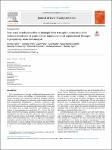Fast-track extubation after orthotopic liver transplant associates with reduced incidence of acute kidney injury and renal replacement therapy: A propensity-matched analysis
| dc.contributor.author | Fabes, J | |
| dc.contributor.author | Wells, G | |
| dc.contributor.author | Abdi, Z | |
| dc.contributor.author | Bhatia, R | |
| dc.contributor.author | Muehlschlegel, P | |
| dc.contributor.author | Fortune-Ely, M | |
| dc.contributor.author | Krzanicki, D | |
| dc.contributor.author | Rahman, S | |
| dc.contributor.author | Spiro, M | |
| dc.date.accessioned | 2024-01-24T10:48:27Z | |
| dc.date.available | 2024-01-24T10:48:27Z | |
| dc.date.issued | 2023-02 | |
| dc.identifier.issn | 2666-9676 | |
| dc.identifier.other | 100137 | |
| dc.identifier.uri | https://pearl.plymouth.ac.uk/handle/10026.1/21932 | |
| dc.description.abstract |
Introduction Liver transplantation is the only available definitive treatment for end-stage liver disease and subtypes of hepatocellular carcinoma. Patient outcomes have significantly improved alongside developments in surgical technique, peri-operative patient optimisation and post-transplantation management [1]. However, it remains a high risk procedure with significant morbidity and mortality attributable in the short term largely to surgical complications and rejection, and in the longer term to organ dysfunction and malignancy, often related to immunosuppressive medication [2,3]. Due to the challenges inherent to the surgical procedure, traditional post-operative management has been to maintain a period of clinical observation while the patient remains mechanically ventilated. However, several centres have demonstrated that a fast-track approach, with tracheal extubation carried out either in theatre or on arrival to the Intensive Care Unit (ICU), is safe in carefully selected patients, and has benefits of reduced ICU and hospital length of stay and their associated costs [4], [5], [6], [7]. | |
| dc.format.extent | 100137-100137 | |
| dc.language | en | |
| dc.publisher | Elsevier BV | |
| dc.subject | 32 Biomedical and Clinical Sciences | |
| dc.subject | 3202 Clinical Sciences | |
| dc.title | Fast-track extubation after orthotopic liver transplant associates with reduced incidence of acute kidney injury and renal replacement therapy: A propensity-matched analysis | |
| dc.type | journal-article | |
| plymouth.volume | 9 | |
| plymouth.publisher-url | http://dx.doi.org/10.1016/j.liver.2022.100137 | |
| plymouth.publication-status | Published | |
| plymouth.journal | Journal of Liver Transplantation | |
| dc.identifier.doi | 10.1016/j.liver.2022.100137 | |
| plymouth.organisational-group | |Plymouth | |
| plymouth.organisational-group | |Plymouth|Faculty of Health | |
| plymouth.organisational-group | |Plymouth|Users by role | |
| plymouth.organisational-group | |Plymouth|Users by role|Academics | |
| plymouth.organisational-group | |Plymouth|Faculty of Health|Peninsula Medical School | |
| dcterms.dateAccepted | 2023-12-21 | |
| dc.date.updated | 2024-01-24T10:48:27Z | |
| dc.rights.embargodate | 2024-1-27 | |
| rioxxterms.versionofrecord | 10.1016/j.liver.2022.100137 |


